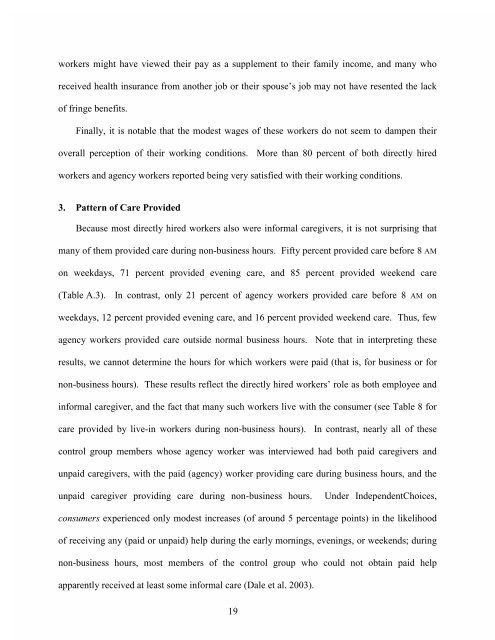The Experiences of Workers Hired Under Consumer Direction in ...
The Experiences of Workers Hired Under Consumer Direction in ...
The Experiences of Workers Hired Under Consumer Direction in ...
You also want an ePaper? Increase the reach of your titles
YUMPU automatically turns print PDFs into web optimized ePapers that Google loves.
workers might have viewed their pay as a supplement to their family <strong>in</strong>come, and many whoreceived health <strong>in</strong>surance from another job or their spouse’s job may not have resented the lack<strong>of</strong> fr<strong>in</strong>ge benefits.F<strong>in</strong>ally, it is notable that the modest wages <strong>of</strong> these workers do not seem to dampen theiroverall perception <strong>of</strong> their work<strong>in</strong>g conditions. More than 80 percent <strong>of</strong> both directly hiredworkers and agency workers reported be<strong>in</strong>g very satisfied with their work<strong>in</strong>g conditions.3. Pattern <strong>of</strong> Care ProvidedBecause most directly hired workers also were <strong>in</strong>formal caregivers, it is not surpris<strong>in</strong>g thatmany <strong>of</strong> them provided care dur<strong>in</strong>g non-bus<strong>in</strong>ess hours. Fifty percent provided care before 8 AMon weekdays, 71 percent provided even<strong>in</strong>g care, and 85 percent provided weekend care(Table A.3). In contrast, only 21 percent <strong>of</strong> agency workers provided care before 8 AM onweekdays, 12 percent provided even<strong>in</strong>g care, and 16 percent provided weekend care. Thus, fewagency workers provided care outside normal bus<strong>in</strong>ess hours. Note that <strong>in</strong> <strong>in</strong>terpret<strong>in</strong>g theseresults, we cannot determ<strong>in</strong>e the hours for which workers were paid (that is, for bus<strong>in</strong>ess or fornon-bus<strong>in</strong>ess hours). <strong>The</strong>se results reflect the directly hired workers’ role as both employee and<strong>in</strong>formal caregiver, and the fact that many such workers live with the consumer (see Table 8 forcare provided by live-<strong>in</strong> workers dur<strong>in</strong>g non-bus<strong>in</strong>ess hours). In contrast, nearly all <strong>of</strong> thesecontrol group members whose agency worker was <strong>in</strong>terviewed had both paid caregivers andunpaid caregivers, with the paid (agency) worker provid<strong>in</strong>g care dur<strong>in</strong>g bus<strong>in</strong>ess hours, and theunpaid caregiver provid<strong>in</strong>g care dur<strong>in</strong>g non-bus<strong>in</strong>ess hours. <strong>Under</strong> IndependentChoices,consumers experienced only modest <strong>in</strong>creases (<strong>of</strong> around 5 percentage po<strong>in</strong>ts) <strong>in</strong> the likelihood<strong>of</strong> receiv<strong>in</strong>g any (paid or unpaid) help dur<strong>in</strong>g the early morn<strong>in</strong>gs, even<strong>in</strong>gs, or weekends; dur<strong>in</strong>gnon-bus<strong>in</strong>ess hours, most members <strong>of</strong> the control group who could not obta<strong>in</strong> paid helpapparently received at least some <strong>in</strong>formal care (Dale et al. 2003).19
















